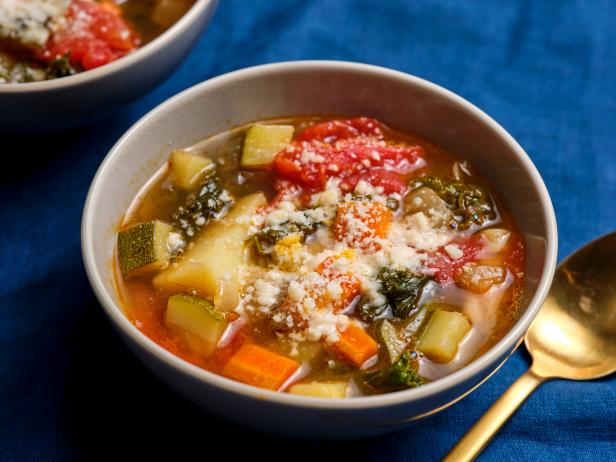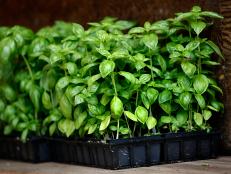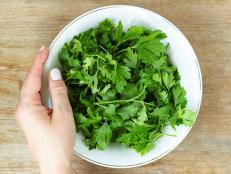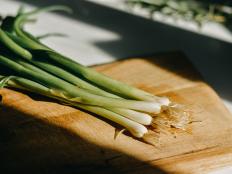How to Preserve Basil
Four ways to keep sweet, fragrant basil around for months. Plus some of our best basil recipes for putting it to work.

tesdei/Getty Images
By Alice K. Thompson for Food Network Kitchen
Alice is a contributing writer and editor at Food Network.
Basil’s sweet, heady flavor of is one of summer’s joys, and there’s no reason you have to say goodbye to it when the season ends. Freezing it whole or in oil, drying it or making it into pesto lets you keep basil around for months. It’s easy and convenient, and having it on hand will save you the hassle and expense of trying to find fresh basil out of season. Here are the best ways we know to preserve it, plus some great recipes that will take you through fall, winter and spring.
How to Preserve Basil: Four Ways to Try
It may smell bold, but basil’s leaves are surprisingly delicate and will begin to wilt and lose aromatic oils soon after harvest. Store it properly and it will keep for a few days, but, if you’ve got a bigger bounty, choose one or more of our easy freezing or drying techniques. All preserve basil’s flavor extremely well, but be aware that its just-picked aroma will fade so it's better to use preserved basil in cooked dishes, not as a garnish.
How to Freeze Basil Whole
Freezing whole leaves is a versatile way to preserve basil. Blanching the leaves first helps retain color and texture, so don’t skip this step.
Step one: Bring to a boil. Bring a large pot of water to a boil and have a bowl of ice water ready.
Step two: Blanch. Place several stems of basil at a time in the boiling water. Let them sit just 3 or 4 seconds, then immediately use tongs to transfer them to the ice bath. Let cool about 30 seconds.
Step three: Dry thoroughly. Lift the stems out, shaking off excess water. Pick off the leaves and lay them out on paper towels or place them in a salad spinner. Dry the leaves as thoroughly as possible.
Step four: Pack and freeze. Lay the leaves in a single layer on parchment or plastic wrap. Roll up, slip the paper into a resealable freezer bag, remove excess air and freeze for up to 3 months.
Use the leaves straight from frozen for any cooked dish; you can chop them first if you like.

Getty Images
How to Freeze Basil in Oil
Freezing basil in olive oil is particularly effective at preserving its aromatic oils. You can either puree it in a food processor, or simply chop it and mix it with oil.
Step one: Rinse and dry. Rinse the basil, remove the leaves from the stems and pat the leaves dry.
Step two: Puree with oil. Place the leaves in a food processor and add puree with 1 to 2 tablespoons of oil per cup of leaves. Or stack several leaves on top of each other, roll them up like a cigar and slice across the roll to make thin strips; combine the strips with olive oil.
Step three: Freeze. Spoon the oil and basil into a ice-cube tray. Freeze until solid, about 3 hours, then transfer the cubes to a resealable bag and freeze for up to 3 months.
You can add the cubes straight into sauces or soups, or thaw them on the counter or in the fridge for an hour or two and drizzle the oil over soups or vegetables or use it in vinaigrette.

victoriya89/Getty Images
How to Dry Basil
Dried basil loses some of its color and fragrance, but this is still a very convenient way to preserve it. Plus it will last up to 6 months stored in a cool, dark cupboard.
Step one: Rinse and dry. Rinse basil leaves and then dry them very well (damp leaves will not dry successfully). Lay the leaves in a single layer on baking sheets covered with parchment paper or on the racks of a dehydrator.
Step two: Dehydrate the leaves. Bake the herbs in the oven at 175 degrees or the lowest setting of your oven until completely dried and crisp, about 2 hours, or follow the manufacturer’s directions for drying herbs in your dehydrator.
Step three: Crumble and store. Allow the basil to cool completely, then gently crumble the leaves and transfer them to airtight jars. Label and date them and use the basil within 6 months.
You can also dry basil in the microwave following these simple directions.
How to Freeze Pesto
Pesto is the go-to basil dish for many of us, and that’s good news: This sauce is super-easy to make and freezes amazingly. Making up a few batches during the season and stashing them in the freezer is one of the best ways to preserve basil.
Step one: Make pesto. Follow your favorite recipe for pesto. Divide it between airtight containers; 8-ounce (1-cup) portions are convenient. Be sure to leave at least 1/2 inch airspace at the top to allow for expansion.
Step two: Seal and freeze. Drizzle the top of the pesto with a little olive oil. Seal, label and date the containers and use the pesto within 6 months. Thaw the pesto on the counter for an hour or two or in the fridge overnight.
If you use pesto in smaller amounts — as a garnish for soups, for instance — you can also freeze it in ice-cube trays, transfer the frozen cubes to a resealable plastic bag and use it within 3 months.
Recipes for Preserved Basil

Food Styling: Vivian Lui Prop: Marina Malchin
Frozen basil leaves, basil in oil or even dried basil will work beautifully in the quick-cooked sauce. Just substitute them for fresh leaves to taste and you’ll save yourself the bother of tracking down fresh basil when it’s out of season.

Nothing could be simpler than this four-ingredient sauce for salmon, steak or vegetables. Or use it as a spread for sandwiches and wraps for instant summer flavor. You can use thawed frozen basil leaves to make it, or decrease the mayo slightly and use basil pureed in oil.

Caitlin Ochs
Veggie-packed minestrone is a year-round favorite but particularly satisfying in the cooler months. Give it a hint of summer flavor by topping each bowl with a drizzle of basil in olive oil or homemade pesto. If you’ve got dried basil you can substitute a teaspoon or so for the bay leaves in the recipe.

Armando Rafael
Use a little of your prepared pesto in this crowd-pleaser for chips or crudite. You can also use this popular dip as a sauce for chicken cutlets, Buffalo wings or burgers.

Armando Rafael
Got frozen basil leaves into November? Nothing could be a better reminder of summer than this golden, buttery turkey.
Related Links:





























































